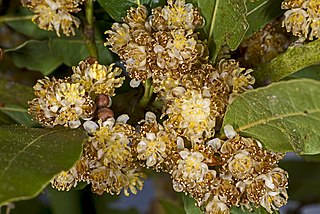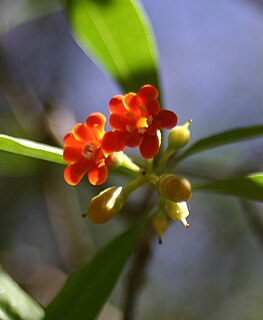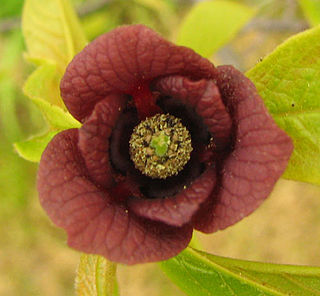
Commelinales is an order of flowering plants. It comprises five families: Commelinaceae, Haemodoraceae, Hanguanaceae, Philydraceae, and Pontederiaceae. All the families combined contain over 885 species in about 70 genera; the majority of species are in the Commelinaceae. Plants in the order share a number of synapomorphies that tie them together, such as a lack of mycorrhizal associations and tapetal raphides. Estimates differ as to when the Commelinales evolved, but most suggest an origin and diversification sometime during the mid- to late Cretaceous. Depending on the methods used, studies suggest a range of origin between 123 and 73 million years, with diversification occurring within the group 110 to 66 million years ago. The order's closest relatives are in the Zingiberales, which includes ginger, bananas, cardamom, and others.

The Fabales are an order of flowering plants included in the rosid group of the eudicots in the Angiosperm Phylogeny Group II classification system. In the APG II circumscription, this order includes the families Fabaceae or legumes, Quillajaceae, Polygalaceae or milkworts, and Surianaceae. Under the Cronquist system and some other plant classification systems, the order Fabales contains only the family Fabaceae. In the classification system of Dahlgren the Fabales were in the superorder Fabiflorae with three families corresponding to the subfamilies of Fabaceae in APG II. The other families treated in the Fabales by the APG II classification were placed in separate orders by Cronquist, the Polygalaceae within its own order, the Polygalales, and the Quillajaceae and Surianaceae within the Rosales.

The Laurales are an order of flowering plants. They are magnoliids, related to the Magnoliales.

The Magnoliales are an order of flowering plants.

Sapindales is an order of flowering plants. Well-known members of Sapindales include citrus; maples, horse-chestnuts, lychees and rambutans; mangos and cashews; frankincense and myrrh; mahogany and neem.

The Santalales are an order of flowering plants with a cosmopolitan distribution, but heavily concentrated in tropical and subtropical regions. It derives its name from its type genus Santalum (sandalwood). Mistletoe is the common name for a number of parasitic plants within the order.

Hamamelidales is an order of flowering plants formerly accepted in a number of systems of plant taxonomy, including the Cronquist system published in 1968 and 1988. The order is not currently accepted in the Angiosperm Phylogeny Group III system of plant taxonomy, the most widely accepted system as molecular systematic studies have suggested that these families are not closely related to each other. The APG II system (2003) assigns them to several different orders: Hamamelidaceae and Cercidiphyllaceae to Saxifragales, Eupteleaceae to Ranunculales, Platanaceae to Proteales, and Myrothamnaceae to Gunnerales. Additional studies of the chloroplast genome have since confirmed that the families moved into the Saxigragales are closely related.

The Nymphaeales are an order of flowering plants, consisting of three families of aquatic plants, the Hydatellaceae, the Cabombaceae, and the Nymphaeaceae. It is one of the three orders of basal angiosperms, an early-diverging grade of flowering plants. At least 10 morphological characters unite the Nymphaeales. One of the traits is the absence of a vascular cambium, which is required to produce both xylem (wood) and phloem, which therefore are missing. Molecular synapomorphies are also known.

The Dilleniales are an order of flowering plants, potentially containing one family, Dilleniaceae. The APG III system of 2009, like the earlier APG II system of 2003, left the Dilleniaceae unplaced as to order, while noting that the name Dilleniales was available. Stevens at the Angiosperm Phylogeny Website has subsequently placed Dilleniaceae in the order Dilleniales.

Nepenthales is an order of carnivorous flowering plants in the Cronquist system of plant classification.

Austrobaileyales is an order of flowering plants consisting of about 100 species of woody plants growing as trees, shrubs and lianas. The best-known species is Illicium verum, commonly known as star anise. The order belongs to the group of basal angiosperms, the ANA grade, which diverged earlier from the remaining flowering plants. Austrobaileyales is sister to all remaining extant angiosperms outside the ANA grade.

The Zygophyllales are an order of dicotyledonous plants, comprising the following two families:

The Angiosperm Phylogeny Group (APG) is an informal international group of systematic botanists who collaborate to establish a consensus on the taxonomy of flowering plants (angiosperms) that reflects new knowledge about plant relationships discovered through phylogenetic studies.

Asphodelaceae is a family of flowering plants in the order Asparagales. Such a family has been recognized by most taxonomists, but the circumscription has varied widely. In its current circumscription in the APG IV system, it includes about 40 genera and 900 known species. The type genus is Asphodelus.

In the APG IV system (2016) for the classification of flowering plants, the name asterids denotes a clade. Asterids is the largest group of flowering plants, with more than 80,000 species, about a third of the total flowering plant species. Well-known plants in this clade include the common daisy, forget-me-nots, nightshades, the common sunflower, petunias, yacon, morning glory, sweet potato, coffee, lavender, lilac, olive, jasmine, honeysuckle, ash tree, teak, snapdragon, sesame, psyllium, garden sage, table herbs such as mint, basil, and rosemary, and rainforest trees such as Brazil nut.

Peridiscaceae is a family of flowering plants in the order Saxifragales. Four genera comprise this family: Medusandra, Soyauxia, Peridiscus, and Whittonia., with a total of 12 known species. It has a disjunct distribution, with Peridiscus occurring in Venezuela and northern Brazil, Whittonia in Guyana, Medusandra in Cameroon, and Soyauxia in tropical West Africa. Whittonia is possibly extinct, being known from only one specimen collected below Kaieteur Falls in Guyana. In 2006, archeologists attempted to rediscover it, however, it proved unsuccessful.

Myrothamnus is a genus of flowering plants, consisting of two species of small xerophytic shrubs, in the southern parts of tropical Africa and in Madagascar. Myrothamnus is recognized as the only genus in the family Myrothamnaceae.

In plant taxonomy, commelinids is a clade of flowering plants within the monocots, distinguished by having cell walls containing ferulic acid.

Theophrastoideae is a small subfamily of flowering plants in the family Primulaceae. It was formerly recognized as a separate family Theophrastaceae. As previously circumscribed, the family consisted of eight genera and 95 species of trees or shrubs, native to tropical regions of the Americas.

Magnoliids are a clade of flowering plants. With more than 10,000 species, including magnolias, nutmeg, bay laurel, cinnamon, avocado, black pepper, tulip tree and many others, it is the third-largest group of angiosperms after the eudicots and monocots. The group is characterized by trimerous flowers, pollen with one pore, and usually branching-veined leaves.




















